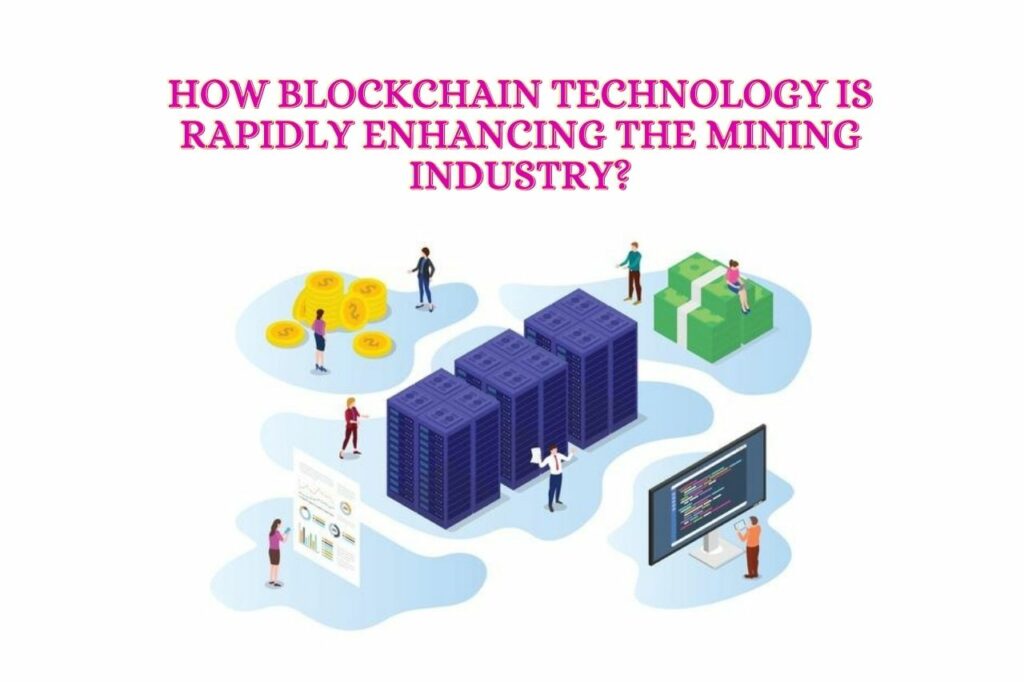How Blockchain Technology is rapidly enhancing the Mining Industry?

The underlying foundations of mining start from the Stone Age, nearly 5000 years back yet with heading and energy produced the cycles have changed by and large. However this area is as yet in a creating stage, it is accepting development and new innovations. One such technology for which the mining industry has the chance to be a quick adopter is Blockchain technology.
Blockchain technology was presented about 10 years back and its organizer, Satoshi Nakamoto depicted this technology as a chain of digital signatures. Most businesses, particularly monetary institutions, are effectively embracing Blockchain technology in their current frameworks. Blockchain in the mining industry is rapidly and adequately making its coming, and this is significant because of the variety of advantages given by the technology.
A hindrance to effectiveness — admittance to precise, real-time data
Enhancing efficiency in huge undertakings, remembering those for the mining industry, frequently boils down to more readily admittance to precise, constant data.
Today, the decision for sharing data typically boils down to two strategies: utilizing email to send records and data straightforwardly or utilizing a trusted outsider going about as an information store. The two strategies are awkward, regularly shaky, and data is outdated when it’s sent.
Blockchain technology opens the way to productive data sharing
Blockchain technology takes care of a few issues with conventional data sharing innovations. Different firms like MineHub by IBM for instance, have set up a consortium of driving industry members — including industry-driving mining, technology, and banking organizations — to help fabricate a blockchain stage to oversee high-esteem resources across the inventory network, from the mine to end purchaser. Organizations take part in a typical network on which to share information, killing the requirement for a confided-in outsider to deal with the information and exchanges.
Businesses’ consortium depends on industry-driving technology, administrations
Taking the example again, MineHub at first fostered the consortium freely, yet it then, at that point, chosen to search out technology accomplices with blockchain skills. It, at last, choose IBM for two: IBM Blockchain technology and the business worth and ability of its specialized administrations. In view of its current associations with a considerable lot of the consortium individuals on the stage, IBM’s investment helped support certainty that they could convey the technology-dependent on the prerequisites and timetables that they spread out. Utilizing the IBM Blockchain Platform permitted them to build an exceptionally protected and private blockchain stage that meets, yet additionally surpasses the necessities of the MineHub consortium individuals.
Also Read:
Future difficulties and openings for the blockchain consortium
In case somebody is considering building a comparable consortium upheld by blockchain technology, the main thing we would say is that the actual technology isn’t as perplexing.
Areas of Application of Blockchain in the mining industry
The elements of Blockchain technology address various areas in mining. Blockchain can change the mining business measures with the accompanying applications:
1. Designing, and handover of mining sites
The designing and development organizations produce complex designing data in designs that are organized and unstructured. Overseeing a particularly broad weight of data builds expenses, and deferral in the administration of data can prompt a fall-back of large business objectives.
Blockchain technology can assist with making the exchanges recognizable and facilitate the complicated cycles of the board of guidelines and principles. Proficient administration of data set guarantees trust and work consistency.
2. Mining lease board
The mining industry needs to deal with the records identified with asset and hold assessment, investigation, mine plan, and arranging measures. The mining industry needs a more controlled component of authority and control with confirmation of endorsement inserted on the archives.
Blockchain technology assists with working on the recognizability of the hold assessment for stock administration and better detectability for stock administration through blockchain. Blockchain can likewise use the idea of keen agreements which can be stretched out to outer elements.
3. Mineral provenance
Assembling associations are especially worried about the provenance of minerals. Following the wellspring of minerals becomes imperative to guarantee the legitimate exchange of minerals. Many assembling organizations have chosen not to utilize minerals that are being provided from struggle zones or mining organizations that don’t keep legitimate ecological guidelines.
Blockchain technology has an expansive business network of resources and exchanges that assistance to follow the mineral inventory network.
4. Inventory network
Blockchain technology can be utilized to follow the materials in the mining esteem chain from the squares and cement to metal. This data can be deliberately displayed from the provenance to the last shopper. Blockchain additionally assists with giving straightforwardness and transparency to its mining accomplices, as the vast majority of the mining businesses have divided inventory chains that have exchanges spread across various gatherings.
Blockchain prompts the mechanization of receipt compromise and the task of the quality authentication that the client ships off lab testing for consolation. This entire interaction coordinates Blockchain and prompts a better production network for the executives.
5. Mining hardware OEM
Mining hardware OEM assets the parts from different places and cooperates in a climate that is superior. At the point when basic disappointment circumstances happen in a store network, the main hotspot for seller data is OEM. Getting data from OEM can be a drawn-out and lumbering interaction.
At the point when Blockchain is connected to the pertinent piece of the OEM contract, the approval to see the data of that part is effortlessly gotten. Through blockchain frameworks, the two customers and OEM can cooperate and are guaranteed of the nature of parts and frameworks utilized.
Conclusion
Taking everything into account, the potential advantages that Blockchain presents for straightforwardness, transparency, and detectability along the inventory chains are various. Blockchain technology permits the information to be approved and put away as an unchanging ‘block’. From assisting the members with approving the exchanges to building trust in exchanges, Blockchain technology can make the inventory chains more proficient and reshape the general mining industry.


